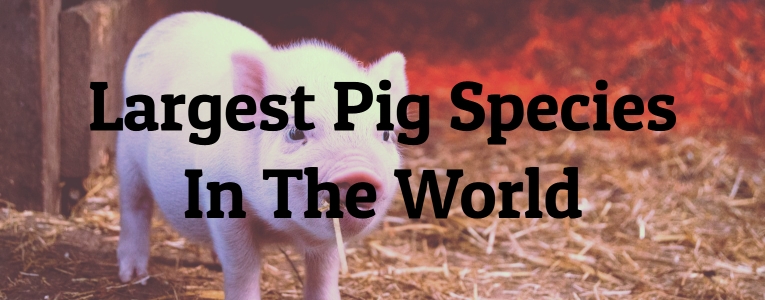Pigs are fascinating animals that come in all shapes and sizes. One pig species is larger than the others. This specific pig species is recognized for its amazing size and power, making it a fearsome beast in the animal realm.
The diet of this pig species consists of a variety of foods, including fruits, vegetables, and grains. They eat a lot at once.
One of the most notable physical characteristics of a pig species is its size. They’re tall and weigh several hundred pounds. Their size and strength make them well-suited for tasks that require heavy lifting or pulling.
This pig species is surprisingly agile and can move quickly, when necessary, despite their large size. They are also quite intelligent and have been known to learn tricks and commands from their human handlers.
In addition to their physical size and strength, this pig species is known for its distinctive appearance. Pigs vary in color and fur texture.
Overall, the largest pig species in the world is a remarkable creature that is truly a sight to behold. Their size and strength are awe-inspiring, and their friendly disposition makes them a joy to be around. Learn about the 8 largest pig species in the world.
-
Landrace Pig
Average Weight: 600 pounds
Habitat: Dependent on subspecies
Estimated Lifespan: 6 – 10 years
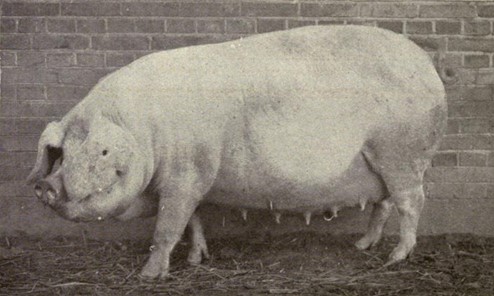 Source: Wikimedia
Source: Wikimedia
Landrace pigs are domestic pigs noted for their high-quality meat, efficient production, and excellent mothering. One of the most extensively spread pig breeds, they originated in Denmark in the late 19th century. Pig producers appreciate landrace pigs for their fast development and toughness.
Landrace pigs are gentle and simple to handle. They love to live in herds, where they may form deep relationships. Landrace mothers zealously protect their piglets from predators. Landrace pigs are smart, inquisitive, and flexible, making them ideal agricultural animals.
Farmers and homesteaders prize landrace pigs for their fast development, toughness, and adaptability. Their beef is world-class. Landrace pigs are useful on farms and homesteads due to their docility, maternal instincts, and versatility.
Did You Know?
Landrace pigs are omnivores. They love cereals, fruits, veggies, meat, and dairy. Landrace pigs may also survive in woods, meadows, and deserts. They thrive in temperate regions with enough water.
-
British Saddleback
Average Weight: 650 pounds
Habitat: United Kingdom
Estimated Lifespan: 12 – 14 years
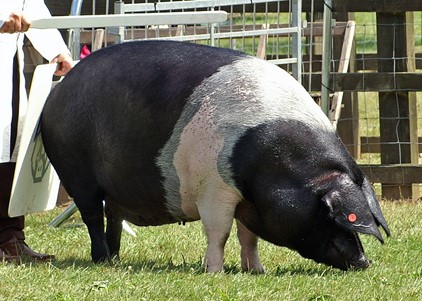 Source: Wikimedia
Source: Wikimedia
The UK-bred British Saddleback is a unique subspecies of the pig. Its striking markings, mild demeanor, and high-quality meat make it the seventh biggest pig species in the world.
Essex and Wessex Saddlebacks are said to have bred the British Saddleback. Once the breeds merged, it was recognized in 1967. This combination created a robust, foraging pig that could generate high-quality meat.
British Saddleback pigs are huge, with mature sows reaching 250–350 kilograms and boars 300–400 kilograms. The breed features black fronts and white backs. They have big snouts, enormous floppy ears, and long, curling tails.
Smallholders and hobby farmers love the mild British Saddleback. For family farms, the breed is amiable and simple to manage.
Did You Know?
British Saddleback pigs are scarce, having just a few thousand globally. Industrial pig farming and agricultural monoculture are endangering the breed.
-
Yorkshire
Average Weight: 700 pounds
Habitat: Americas
Estimated Lifespan: 15 – 20 years
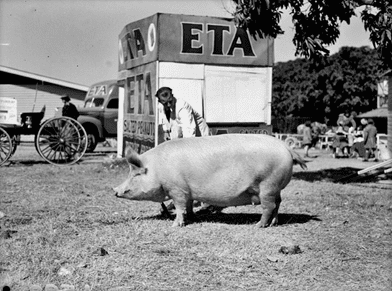 Source: Wikimedia
Source: Wikimedia
Yorkshire pigs, sometimes known as Big Whites, originated in Yorkshire, England. These pigs are marketed worldwide for their high-quality meat. They are the sixth biggest pig species and contributed to modern pig husbandry.
Yorkshire pigs have contributed to contemporary pig farming. They are noted for their high-quality meat, quick development, and friendliness. They are still grown by farmers worldwide, despite certain obstacles in contemporary farming.
Did You Know?
Yorkshire pig breeders carefully bred their pigs for meat output in the 18th century. The breed evolved to produce leaner, bigger pigs with high-quality meat. Yorkshire pigs were brought to the US in the early 19th century, when farmers and customers loved them.
-
Red Wattle Hog
Average Weight: 800 pounds
Habitat: USA
Estimated Lifespan: 9 – 15 years
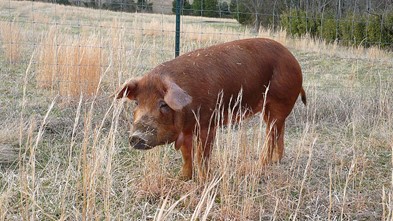 Source: Wikimedia
Source: Wikimedia
Red Wattle Hogs are unusual and distinctive. It is called for its huge, fleshy neck wattles. The world’s fifth biggest pig breed is praised for its succulent and tasty flesh.
Texas farmers started crossbreeding pig breeds in the early 20th century to produce a resilient variety that could survive in the hot and humid environment. Farmers loved the Red Wattle Hog for its hardiness, flexibility, and high-quality meat.
Despite its popularity, mechanized agriculture and the inclination for leaner meat breeds almost wiped off the breed in the mid-20th century. The Red Wattle Hog is currently a unique species with a rising appeal among customers and farmers thanks to a group of committed farmers and breeders.
Did You Know?
Red Wattle Hogs have specialized dietary and shelter needs, therefore breeding and rearing them takes skill. These pigs need room to forage and a balanced diet of high-quality grains, veggies, and protein.
-
Large Black Pig
Average Weight: 800 pounds
Habitat: Great Britain
Estimated Lifespan: 10 years
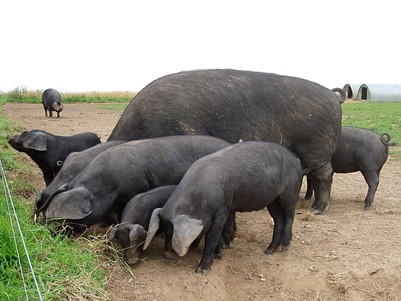 Source: Wikimedia
Source: Wikimedia
The Large Black Pig, commonly known as the Devon or Cornish Black Pig, is a domestic pig breed notable for its unique look, hardiness, and high-quality meat. Pig growers and homesteaders prefer it because it is the fourth-largest pig in the world and has strong maternal instincts.
In the early 1800s, the Berkshire, Tamworth, and Old English Game were crossed to create the Large Black Pig in England. The breed was designed for bacon production and popular in Devon and Cornwall, thus the other names.
The Big Black Pig has a long, deep body and a somewhat small, upturned snout. Its droopy ears reach its nose. Big Black Pigs are gentle and adaptable, thriving in free-range and pasture-based settings.
Did You Know?
Its large, coarse bristles shield the pig from sunlight, biting insects, and bad weather, making it hardy. The Big Black Pig’s black color also helps protect it from sunburn, which can be a severe concern for lighter-colored pig breeds.
-
The Poland China
Average Weight: 800 pounds
Habitat: USA
Estimated Lifespan: 6 – 10 years
 Source: Wikimedia
Source: Wikimedia
The mid-19th century US-bred Poland China pig is a domestic breed. It is the third biggest pig species and known for its high-quality meat and adaptability.
American farmers loved the Poland China pig breed for its toughness and versatility. It thrived in hot and cold settings. Commercial pig farmers liked it because it was disease-resistant.
Poland China pigs are recognized for their size, meat, and friendliness. They’re smart and simple to teach, making them suitable for hobby farms.
Did You Know?
In the 1800s, Ohio crossed the Big China pig, brought from China, with the Poland hog to create the Poland China pig. This genetic mix produced a robust, black-coated pig with white markings.
-
The Duroc
Average Weight: 880 pounds
Habitat: USA
Estimated Lifespan: 15 years
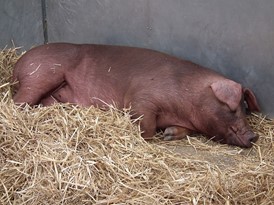 Source: Wikimedia
Source: Wikimedia
The Duroc pig is a domesticated breed of pig that is known for its reddish-brown coat, large size, and excellent meat quality. It is widely considered to be one of the top pork-producing breeds in the world, and is particularly popular in the United States, where it is often used in commercial pig farming operations.
The Duroc pig originated in the United States in the mid-1800s. The breed is a combination of two other pig breeds, the Red Jersey and the old Duroc.
Duroc pigs are widely used in commercial pig farming operations due to their excellent meat quality and high growth rate. They are particularly popular in the United States, where they are often raised in confinement operations and used to produce pork for a variety of products, including bacon, ham, and sausage.
Did You Know?
Duroc pigs are known for their excellent meat quality, which is due to their well-marbled meat and good muscle structure. They have a high percentage of intramuscular fat, which makes their meat juicy and flavorful.
-
The Hungarian Mangalitsa
Average Weight: 1100 pounds
Habitat: Europe, abundant near Hungary
Estimated Lifespan: 15 – 20 years
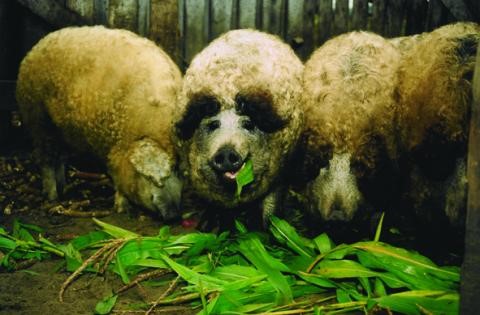 Source: Wikimedia
Source: Wikimedia
The Hungarian Mangalitsa is the largest pig in the world. The world’s largest pig has a curly coat that resembles a sheep or teddy bear. For ages, Mangalitsa meat and fat have been a delicacy in many nations.
Adult male Mangalitsa pigs weigh up to 300 kg (660 lbs) and females up to 250 kg (550 lbs) (550 lbs). Its curly coat is black, golden, or red. The thick, curly coat insulates the pig in even the toughest winters.
Did You Know?
Crossbreeding a native Hungarian pig breed with European wild boar and Serbian swine produced the Mangalitsa breed in the mid-19th century. The Hungarian countryside’s severe climate and steep terrain produced a strong, durable breed.
RELATED READINGS
5 Largest Chicken Breeds in the World
8 Largest Cattle Ranches In The Us
8 Most Expensive Cows in the World
